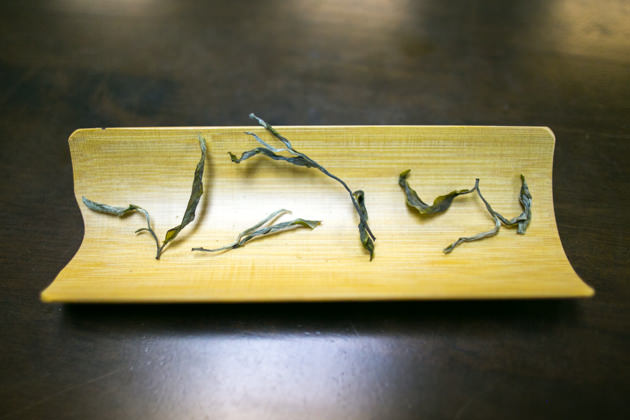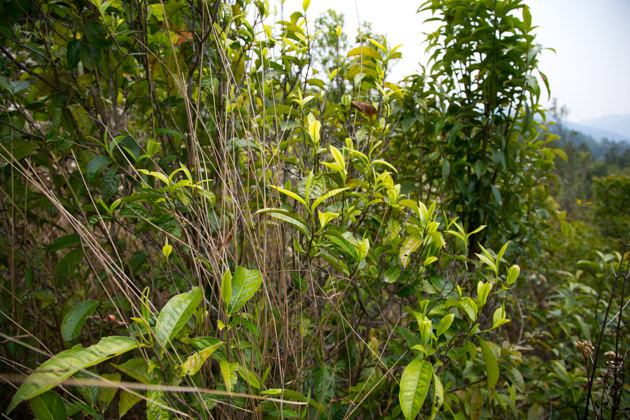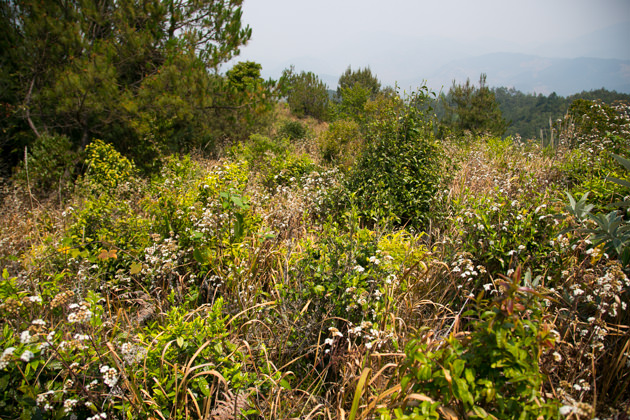- HOME >
- Types of Tea
Producing Exceptionally Long Withered Raw Pu-erh Tea
- [2017.04.29] Posted By Akira Hojo
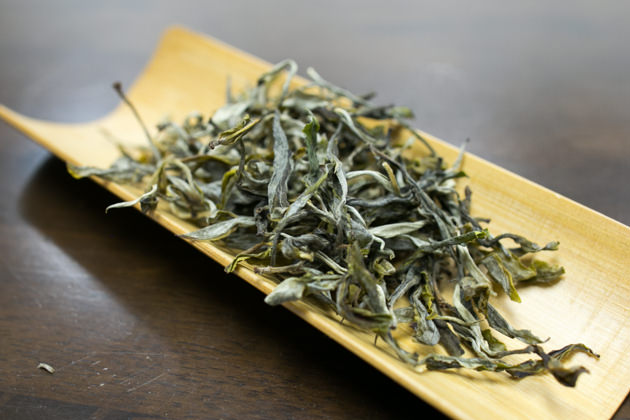
Throughout my years of tea expedition in China and meeting with unaccountable number of tea manufacturers, I learned that most of pu-erh tea manufacturers agreed that “the long withering improves the flavor of tea”. However, I have not seen any pu-erh tea that underwent very long withering. Due to various constrains in their work arrangement, it is very inconvenient for them to conduct long withering. I managed to convince one of my manufacturers who is reliable and has the good skill in process to produce the pu-erh tea with very long withering.
Process flow of raw pu-erh tea
Generally pu-erh tea is processed as the following sequence.
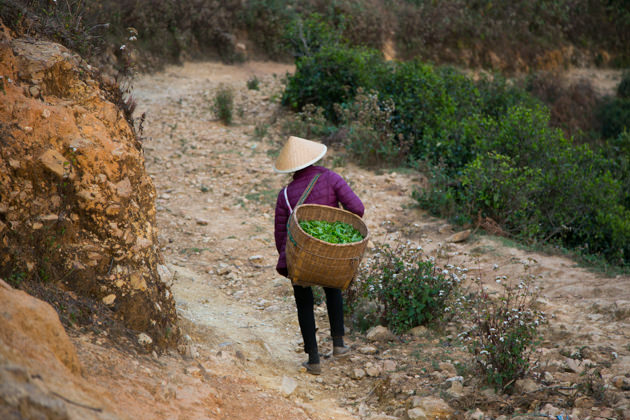
Farmers came back to their village at around 6-7pm and sell the fresh tealeaf collected in a day. Some of them bring the tea back to their home and process it by themselves. Tea is piled at about 15cm thickness and being withered until 9-10pm. In the meantime, farmers are having dinner.



Usually, it is common that factory hires some skilled farmers to work for them at night on the part-time basis. As they are also plucking tea or working on their own farm in the daytime, they only work at the tea factory at night. As soon as after dinner, they will be back to the tea factory. I noticed that quite a number of factories hire the ladies. You may be surprised that most of the skilled tea masters are the ladies on those mountain villages.

After a few hours of withering, tea is fried on pan, slightly cooled down and rolled.
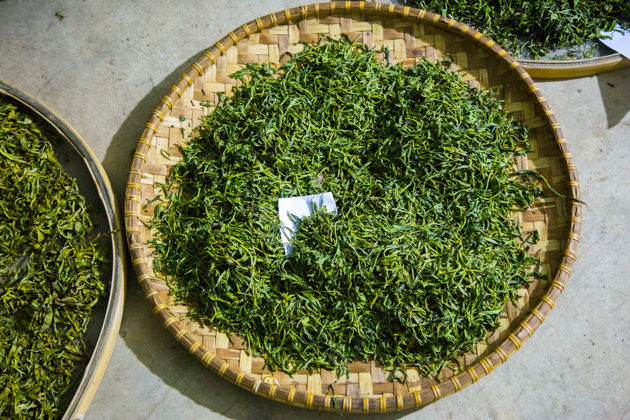
After the rolling process the tea was spread to a thin layer on the mat and leaves it overnight. In the morning, tea will be dried under the sun.
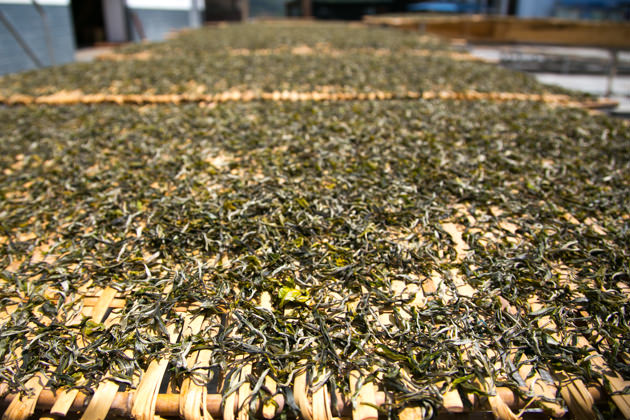
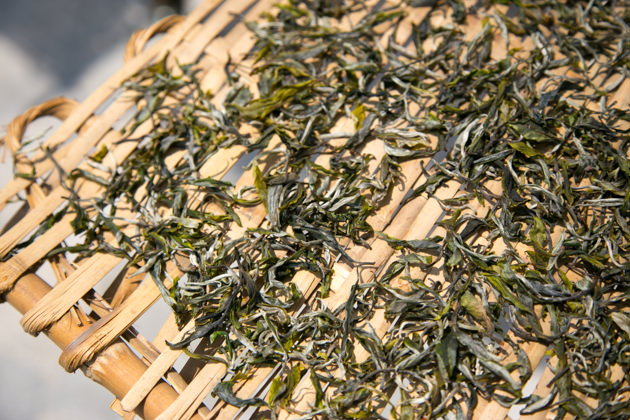
Usually, the withering process is less emphasized. The tea manufacturer pays less attention on this process in making pu-erh tea. The withering process means tea is piled at about 15cm height in the dry environment to let tea leaves gradually evaporate the moisture. The dehydration stress activates the oxidative enzyme (PPO) which then starts the moderate fermentation on tea substances. As a result, tea will produce sweetish floral flavor like flowers.
Difficulty to arrange the longer withering process
The withering process for pu-erh tea also plays a very important role just like that for oolong, white tea and black tea. The sufficient withering produces sweet and floral flavor and it creates richer cup characteristics and multi-layered of aroma. Unexpectedly, a number of manufacturers are well aware that the longer withering will gives tea with better flavor. They knew very well about the importance of withering to make a good pu-erh tea. Unfortunately, in most cases they are unable to carry out efficient withering due to some constrains. As fresh tealeaf is brought back to the tea processing site in the evening, if one wish to conduct long withering process it will take place until midnight or the next day. Usually, those factory workers do have to pluck tea or work in the farm during daytime, they cannot afford to stay up after midnight or work in the factory during daytime.
In the famous tea production area, tea is very popular and many people hope to get the tea. Usually, they will visit the tea gardens and wait to purchase the fresh tealeaf on the spot. The farmers do not even have to bring the tea back to the factory. Since the manufacturers are aware of the importance of withering, we often witness that they are conducting the withering process under the tree while they are waiting for other teas.


Some manufacturers conduct about 6 hours of withering
Most of the good tea gardens located far away from the village. For example it takes more than one hours walk to reach the place where tea trees are naturally grown. The pluckers will stay at the mountain until evening and bring back all their harvest to the tea factory. It’s inefficient and they are not able to collect sufficient tealeaf if they have to come back to village in the afternoon. One of my manufacturers emphasizes on the withering process more than others, and he always tried his very best to conduct longer withering. His method is that he pays more for fresh tea leaf and collect tea in the afternoon instead of evening. So the tea pluckers are willing to come back in the afternoon since he is paying more than the market price to compensate for the lost time in traveling back and forth to the tea garden. If he managed to collect tea at about 3-4pm, he can conduct withering for around six hours. He knows that the longer withered tea gives nicer flavor.
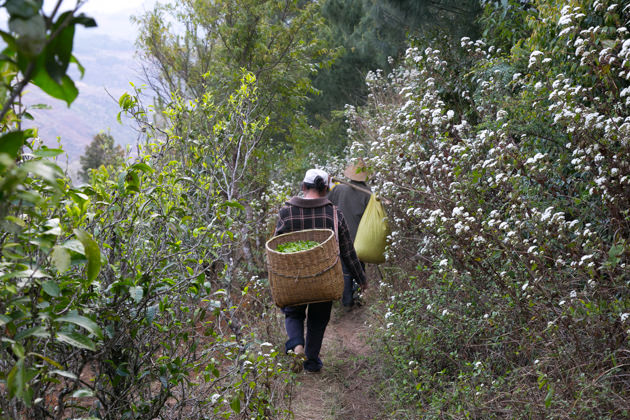
The tea garden is often located a few kilometers away from their village.
The longer the withering, the harder the pan-frying
With efficient withering process, the fresh tea leaves loss more moisture, and the pan-frying process requires higher skill. Many people thought that the pan-frying of tea means heating tea leaf with pan and inactivate the enzyme through the direct heat conduction. However, it is not in this way. The pan-frying is to evaporate the moisture of tea leaf, saturate the steam over the tea leaves and inactivate the enzyme with the heat of steam. With efficient withering process, the moisture in tea leaf is reduced. If pan-frying is not well carried out, tea leaves may either scorched or some enzymes remain active. As a result, tea undergoes further fermentation during sunshine drying process. Ironically, this kind of tea gives quite nice flavor like oolong tea. However, if we carefully judge the quality, it also has a lot of “noises” in taste, such as astringency and slightly fermented tea flavor like fresh black tea. This kind of tea is not very suitable for long term storage. After tea is being kept for a few years, the flavor turns like a over fermented black tea. It is due to the substance called thearubigin that is formed due to the remaining enzyme that is activated during sunshine drying process. The well processed tea regardless of long withering or not gives a very clear flavor and taste. When tea undergoes maturation by aging, the flavor is very clean.

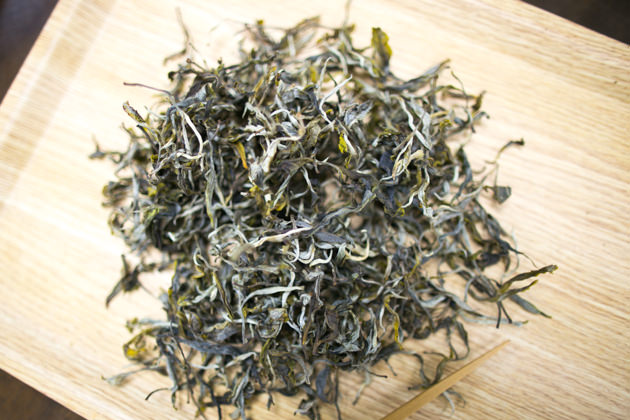
Due to no fertilizer and human care, tea leaves are generally in yellowish color.
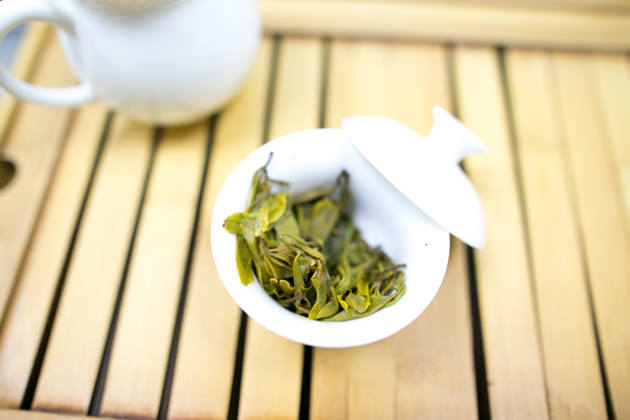
The manufacturer was amused by the outcome
Since a few years ago, I have been enthusiastically wishing to produce pu-erh tea with long withering i.e., more than 12-16 hours. I think more than 12-16 hours withered raw pu-erh tea is an unprecedented kind of tea.
This year, I discussed this project again with a skilled tea master. He has been working with us for many years. He did agree with my concept and he showed strong interest. But he said he could not arrange it due to the shortage of manpower issue. He cannot afford to run the tea production in the daytime. So I discussed with another tea manufacturer whose organization is bigger and he has sufficient number of employees and they can run the pan-frying process during daytime. Initially he was less committed on this project. But I managed to convince him to conduct the experiment to produce a few kilograms of long withered tea. I told him I will buy whichever tea he produced regardless of the outcome is good or bad.
After the experiment, we tasted the tea together with the manufacturer. The first sip tastes like a fresh raw pu-erh tea. However, its lingered finishing is vastly different from ordinary raw pu-erh tea. It gives a floral note and sweetish lingering flavor that is just like Taiwan high mountain oolong. The lingering flavor reminds me of Li Shan Cha. The person who was the most impressed by the outcome was not me, but the manufacturer. It seems he was so shocked by the result and it made him firmly committed on this project. That resulted in we managed to run the long withered raw pu-erh tea production, officially.

The photo above is the tea garden where we collected tea leaves for this project. Although it looks like a wild bush, it is actually a tea garden. We call those tea garden as Ye Fang 野放茶園 in Chinese. It means tea tree is left wild and no human care is given. Those yellowish leaves are tea trees.
We collected fresh tea from the naturally-farmed tea garden
Since we have a chance to produce this very special tea, we worked very hard to obtain good material. Usually if tea garden is located within 5-10km perimeter of the tea factory, we can identify the owners of the particular tea garden through the tea manufacturer. We committed to make a higher payment directly to the owners to ensure the fresh tea leaf is sent to our specified tea factory and not sold to other people.
Tea garden is located at around 2000-2100m. Tea is plucked once a year and no fertilizer or pesticide is used. Thanks to the high altitude and no fertilizer, tea grows very slowly. It produces extraordinarily long lasting aftertaste, multi-layered flavors and sweetness that linger for a long time on our palate.
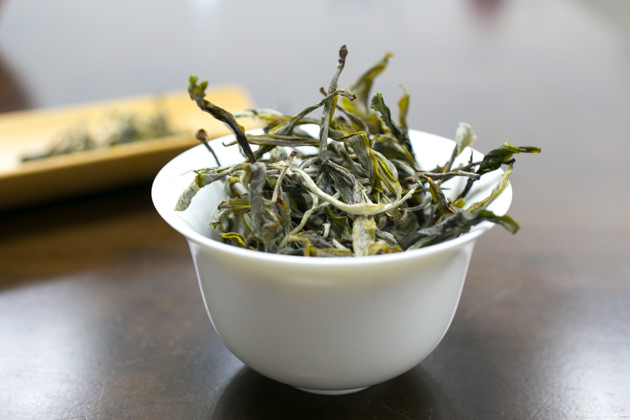
As we are delighted with the outcome, we are planning to release some mao-cha (loose tea) on a pre-booking basis. The balance of the tea will be then compressed into cake. Now we are arranging the hand-sorting process and the actual quantity is yet to be finalized. As soon as we confirm the quantity, we will release the news for pre-booking.
Related Articles
How to get the latest update on HOJO?
1. Follow Twitter, 2. Click "Like" on Facebook, and 3. Subscribe in newsletter. You can have the latest tea news from HOJO.
 Subscribe the Newsletter to enjoy the privileges
Subscribe the Newsletter to enjoy the privileges- You may receive a free sample upon purchase, or you may have the priority to purchase special products. So please remember to subscribe our newsletter as well as the social network.
- Myanmar White Tea Bud 2013 from Guo Gan, Myanmar
- We have released a raw Pu-erh tea, 緬甸白芽茶 2013 (Myanmar White Tea Bud 2013), produced by ethnic minorities in t …
- Yong De Wild White Tea 2025 Loose Leaf Limited Release
- We have released Yong De Wild White Tea Loose 2025. For the 2025 harvest, only the loose-leaf type was …
NEW ARTICLES
 Myanmar White Tea Bud 2013 from Guo Gan, Myanmar
Myanmar White Tea Bud 2013 from Guo Gan, Myanmar- We have released a raw Pu-erh tea, 緬甸白芽茶 2013 (Myanmar White Tea Bud 2013), produced by ethnic minorities in t …
 Yong De Wild White Tea 2025 Loose Leaf Limited Release
Yong De Wild White Tea 2025 Loose Leaf Limited Release- We have released Yong De Wild White Tea Loose 2025. For the 2025 harvest, only the loose-leaf type was …
 Experience the True Freshness of Raw Pu-erh : Tang Jia 2025 Loose Leaf Release
Experience the True Freshness of Raw Pu-erh : Tang Jia 2025 Loose Leaf Release- We have released Tang Jia Raw Pu-erh Tea 唐家古樹生茶 2025 Loose Leaf. Among HOJO’s raw pu-erh teas, Tang Jia Raw Pu …
 Yunnan Chun Jian Green Tea from High Mountain Gardens
Yunnan Chun Jian Green Tea from High Mountain Gardens- Yunnan Chun Jian Green Tea is now available. This tea is made from naturally grown leaves harvested from high …
 Limited Loose Leaf Release of 2025 Da Xue Shan Wild Raw Pu-erh Tea
Limited Loose Leaf Release of 2025 Da Xue Shan Wild Raw Pu-erh Tea- We have released the 2025 loose-leaf version of Da Xue Shan Wild Raw Pu-erh Tea. This tea comes from wild tea …
 Discover a New Way to Enjoy Tea: Cooking Rice with Tea
Discover a New Way to Enjoy Tea: Cooking Rice with Tea- Cooking rice with tea is a simple idea, but it brings surprisingly satisfying results. The tea’s flavour seeps …
 2025 Da Xue Shan Wild White Tea Now Available from Yunnan
2025 Da Xue Shan Wild White Tea Now Available from Yunnan- The 2025 harvest of Da Xue Shan Wild White Tea is now available. Crafted from truly wild Camellia taliensis tr …
 Fresh 2025 Yunnan White Tea – Select Your Favourite Lot Before Blending
Fresh 2025 Yunnan White Tea – Select Your Favourite Lot Before Blending- Freshly crafted in Yunnan and just arrived in KL, our new 2025 white tea is now available at our Gardens Mall …
 2024 Dong Shan Raw Pu-erh Tea – Crafted with the Producer for Desired Quality
2024 Dong Shan Raw Pu-erh Tea – Crafted with the Producer for Desired Quality- We have released the 2024 cake of Dong Shan Raw Pu-erh Tea. Earlier, we offered the loose-leaf version from th …
 Development of Firewood Roasted Hojicha Using Naturally Grown Tea from Yunnan
Development of Firewood Roasted Hojicha Using Naturally Grown Tea from Yunnan- We are currently staying in Yunnan Province for tea production. As the season nears its end, tea trees with pa …
Category
- New Arrival at HOJO Online Shop
- Featured Articles
- Newsletter
- Types of Tea
- Origin of Tea
- Teapot and Tea Equipment
- Tea Column
- How to enjoy tea
- Tea Processing
- How to choose quality tea
- Tea constituents and functional effect
- Safety of Tea
- Foods
- Tea Business Operation
- Hobby and Outdoor Activity
- Ranking of Tea
- Video
- FAQ
- Media Release
Profile

- AKIRA HOJO
- I invite you to experience my tea selections.I was born in Nagano, Japan. In university, I studied agricultural chemistry, and I have the master degree in food science. I worked in Japanese food industry for 10 years. I involved in R&D, QC and QA. As a factory manager, I implemented ISO9000 series and managed the factory.
- The Art of Tea Magazine
- We posted the article on “The Art of Tea Magazine No.9, the magazine is published in Taiwan. We featured …
- New Straits Times
- The Malaysian National Newspaper, New Straits Times featured HOJO Tea on 17-Oct-2007.
Shop Info

Address:Lot No. T-215, 3rd Floor, The Gardens Mall, Mid Valley City, Lingkaran Syed Putra, 59200 Kuala Lumpur
Tel: +603-2287-4537
Business Hour: 10am to 10pm


